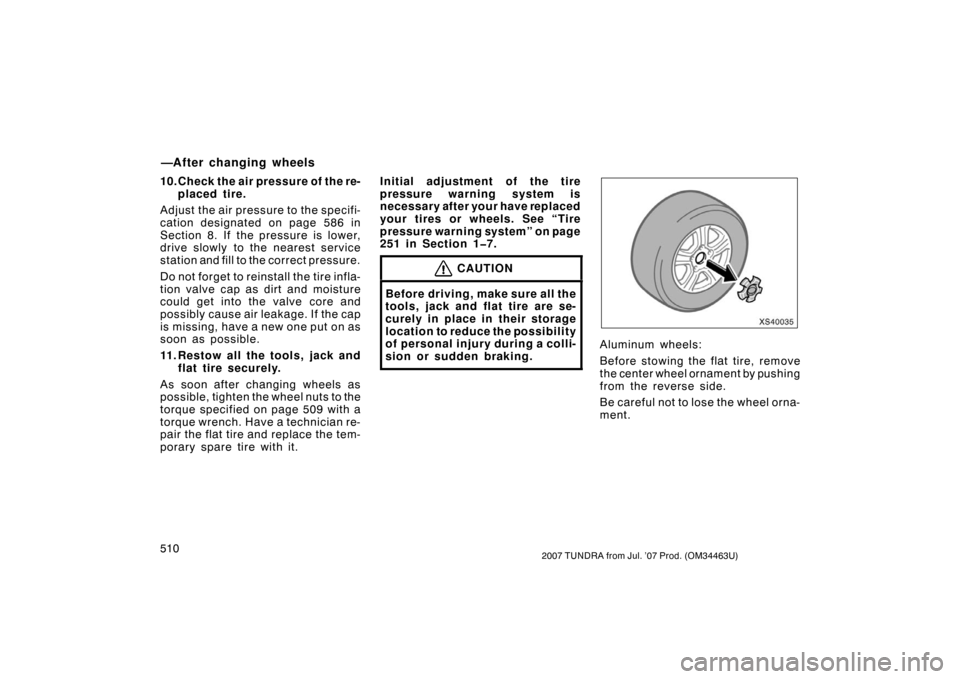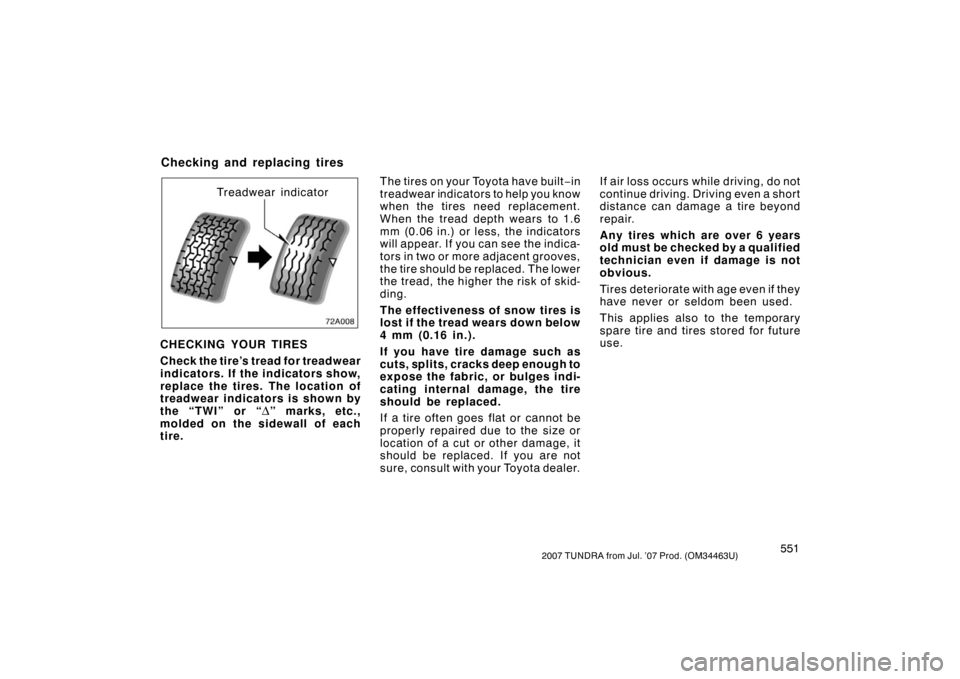Page 511 of 611
5022007 TUNDRA from Jul. ’07 Prod. (OM34463U)
1. Get the required tools and tem-porary spare tire.
1 Tool bag
2Jack
To prepare yourself for an emergency,
you should familiarize yourself with
the use of the jack, each of the tools
and their storage locations.
When storing the tool bag, make sure
it is securely by the tightening strap.
XS40037b
Storage box lid
Before getting the required tools
(Double cab models with the stor-
age box) 1. Remove the right storage box lid by following the procedure below:
1 Turn the knob to the open posi-
tion.
2 Lift the lid to an upright posi-
tion.
3 Slide the lid forward until it dis- engages from the box.
XS40036b
Jack cover
panel
2. Remove the jack cover panel as
shown in the illustration.
Page 519 of 611

5102007 TUNDRA from Jul. ’07 Prod. (OM34463U)
10.Check the air pressure of the re-placed tire.
Adjust the air pressu re to the specifi-
cation designated on page 586 in
Section 8. If the pressure is lower,
drive slowly to the nearest service
station and fill to the correct pressure.
Do not forget to reinstall the tire infla-
tion valve cap as dirt and moisture
could get into th e valve core and
possibly cause air leakage. If the cap
is missing, have a new one put on as
soon as possible.
11. Restow all the tools, jack and flat tire securely.
As soon after changing wheels as
possible, tighten the wheel nuts to the
torque specified on page 509 with a
torque wrench. Have a technician re-
pair the flat tire and replace the tem-
porary spare tire with it. Initial adjustment of the tire
pressure warning system is
necessary after your have replaced
your tires or wheels. See “Tire
pressure warning system” on page
251 in Section 1�7.
CAUTION
Before driving, make sure all the
tools, jack and flat tire are se-
curely in place in their storage
location to reduce the possibility
of personal injury during a colli-
sion or sudden braking.
XS40035
Aluminum wheels:
Before stowing the flat tire, remove
the center wheel ornament by pushing
from the reverse side.
Be careful not to lose the wheel orna-
ment.
—After changing wheels
Page 560 of 611

5512007 TUNDRA from Jul. ’07 Prod. (OM34463U)
Treadwear indicator
CHECKING YOUR TIRES
Check the tire’s tread for treadwear
indicators. If the indicators show,
replace the tires. The location of
treadwear indicators is shown by
the “TWI” or “
Δ” marks, etc.,
molded on the sidewall of each
tire. The tires on your Toyota have built
−in
treadwear indicators to help you know
when the tires need replacement.
When the tread depth wears to 1.6
mm (0.06 in.) or less, the indicators
will appear. If you can see the indica-
tors in two or more adjacent grooves,
the tire should be replaced. The lower
the tread, the higher the risk of skid-
ding.
The effectiveness of snow tires is
lost if the tread wears down below
4 mm (0.16 in.).
If you have tire damage such as
cuts, splits, cracks deep e nough to
expose the fabric, or bulges indi-
cating internal damage, the tire
should be repl aced.
If a tire often goes flat or cannot be
properly repaired due to the size or
location of a cut or other damage, it
should be replaced. If you are not
sure, consult with your Toyota dealer. If air loss occurs while driving, do not
continue driving. Driving even a short
distance can damage a tire beyond
repair.
An y ti res wh i ch are over 6 years
old must be checked by a qualified
technician even if damage is not
obvious.
Tires deteriorate with age even if they
have never or seldom been used.
This applies also to the temporary
spare tire and tires stored for future
use.
Checking and replacing tires